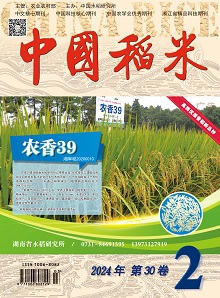A field experiment was carried out in tidal flat of Jiangsu Province (the salt content in the soil is 1.11-1.26 g/kg) in 2021 to study the effects of different exogenous substances and spraying periods (2 times: tillering stage, booting stage and 3 times: tillering stage, booting stage, filling stage) on the panicle traits, yield and quality of rice, taking Nanjing 5055 as the test variety. Seven treatments were set up in the experiment, including spraying clean water (CK), spraying Hejiachun twice (L1-2), spraying Bihu twice (L2-2), spraying Naphthoacetic twice (L3-2), spraying Hejiachun three times (L1-3), spraying Bihu three times (L2-3), and spraying Naphthylacetic three times (L3-3). The results showed that spraying exogenous substances had the effect of improving rice yield. Compared with CK (the rice yield was 7 310.3 kg/hm2), L2-2, L2-3, L3-2, and L3-3 significantly increased rice yields by 17.69%, 17.80%, 11.62%, and 13.42%, while L1-2 and L1-3 increased rice yields by 6.66% and 7.09%, respectively, but the difference was not significant. However, spraying treatments had little effect on quality of rice. Spraying exogenous substances did not significantly affect the effective panicle number and seed setting rate of rice, but significantly increased the number of solid grains. L1-2, L2-2, L1-3 and L3-3 treatments significantly increased the number of grains per spike, while L2-2 and L2-3 treatments significantly increased the weight of 1 000 grains. Spraying exogenous substances did not significantly affect the number of branches, total number of grains, number of solid grains and seed setting rate of primary branches and stems of rice, but increased the number of branches, total number of grains, number of solid grains and seed setting rate of secondary branches of rice, and the contribution rate of secondary branches to grain number per panicle has generally increased. For the same exogenous substance, there was no significant difference in the effects of spraying twice and spraying three times on rice yield and panicle traits. The increase of rice yield under Bihu spraying treatment was mainly caused by the increase of grain number per panicle, solid grain number per panicle and 1000-grain weight. The increase of grain number per panicle under Naphthoacetic spraying treatment was mainly caused by the increase of grain number per panicle and solid grain number per panicle, and the increase of grain number per panicle was mainly related to the increase of the number of secondary branches, the total number of grains and solid grain number of secondary branches. Therefore, when planting rice in the tidal flat in the future, we can improve the spike grain structure, especially the secondary branch characters, by spraying exogenous foliar fertilizer or plant growth regulators at the tillering stage and booting stage, so as to increase rice yield and income.

